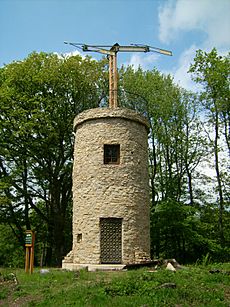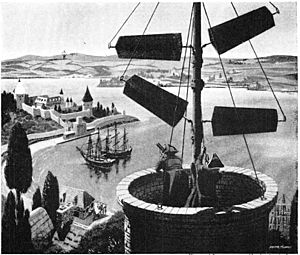Semaphore line facts for kids

A semaphore line is a system that sends messages using light signals. It is also called an optical telegraph. These systems often used tall signal towers with special moving parts, or people holding flags. The message is shown by the position of the parts or flags. You can read the signal when it stays still in one position. Today, "semaphore" usually means sending messages with two hand-held flags.
Signal towers were used before the electric telegraph was invented. They were much faster than sending messages by people riding horses.
Contents
How Semaphore Works
Semaphore systems use different positions of arms or flags to represent letters, numbers, or special codes. Each position has a specific meaning. People would look through telescopes to see the signals from far away. They would then pass the message to the next tower or person. This way, messages could travel long distances quickly.
Early Optical Telegraphs
One of the most famous optical telegraph systems was invented by Claude Chappe in France in the late 1700s. His system used towers with three large, movable arms. These arms could be set in many different positions to show letters and numbers. Chappe's network of towers spread across France, allowing the government to send important news and orders much faster than before.
Other countries also developed their own optical telegraphs. For example, in Britain, a system using large shutters was used. These shutters could be opened or closed in different patterns to send messages.
Semaphore Flags Today
While optical telegraph towers are no longer used, the idea of semaphore lives on with flags. Sailors and people in the military still use semaphore flags to communicate silently over short distances. Each letter of the alphabet and each number has a specific flag position.
Semaphore Characters
The following pictures show the different positions for semaphore characters, as if you were looking at the person holding the flags:
Images for kids
-
Sir Richard Lovell Edgeworth's proposed optical telegraph for use in Ireland.
-
A Chappe semaphore tower near Saverne, France
-
St. Albans High Street in 1807, showing the shutter telegraph on top of the city's Clock Tower.
-
Ta' Kenuna Tower, a semaphore tower in Nadur, Gozo, Malta, built by the British in 1848.
-
Restored semaphore in Adanero, Spain.
-
A cartoon strip of "Monsieur Pencil" (1831) by Rodolphe Töpffer.
See also
 In Spanish: Telégrafo óptico para niños
In Spanish: Telégrafo óptico para niños












































